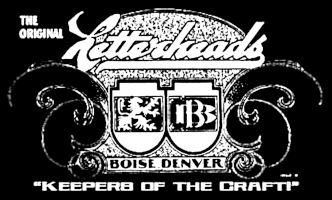Posted by Mike Jackson on November 16, 2003
A few days ago, I looked over Rawson and Evans patent #494,999 and gave a brief synopsis of the content of the patent. You can scroll down and see it. There are another four or five patents listed on the new Rawson & Evans main page. I would invite a few of you to pick a patent and read through it thoroughly, then give us a similar brief synopsis or review of the process and materials.
We'd probably all like to know what they patented, but don't feel like trying to decipher each one of them.
Thanks in advance to anyone wanting to tackle the project....Danny? Robare? Larry? Carol? Anyone?
Mike Jackson
Danny Baronian
Danny BaronianAfter reading patient no 495,000 "Process of Ornamenting Glass",you realize the lawyers were peddling their trade much like today - three pages of text with the same content. I printed this one up, dealing with the glue chipping process. Reading the patient took concentration, you'd realize you've read the same paragraph, stated in a slightly different way, 10 - 15 times.
What I learned from this patient is that they applied a coat of shellac, put down a mask (zinc) blasted, coated the entire surface with asphaltum, put down the same mask again and blasted again. It's as though they were putting down a double barrier, and adding thickness to the mask.
Aware of blasting equipment they had - or lack of - the glass was barely frosted. Rick always stressed to just frost the glass, but like everyone else blasted a little longer because it was 'better'. Blasting deeper allows the glue to get a better bite on the edges and chip beyond where you want it to.
After masking, they poured the glue over the entire surface. It did not say weather they design once the glue gelled set up. Considering the quantity of work they did, using a squeeze bottle to apply the glue would be impractical. Unless you cut around the design the glue would bridge areas you want to remain clear. If anyone has a different insight to this, I'd like to know.
Danny
Robare M. NovouLast paragraph read: It did not say weather they design once the glue gelled set up.
Should have been: It did not say whether they cut around the design once the glue gelled up.
Danny
Danny BaronianShould really have read....It did not say "whether" they cut around the design once the glue gelled up.
RMN
That's it? The Sign Police is checking my spelling, and no others delving into the patients?
Weather, whether, whatever. :–)
Danny
Robare M. Novou
Robare M. NovouWe have here at "Just the Facts, Ma'am.", are in the belief that if your spelling is correct, than your facts are correct. But if your spelling is amiss, than the facts may be slightly amiss.
So is it Patients or Patents?
And when was the last time you saw a patient with a patent?
And in reference(correction) to your version of patent #495,000. They used two blasting masks of zinc, pattern "A", which was a metal plate with the letters cut out, for blasting just the letters.
And pattern "A'" which was metal letters with ties, and used to blast away the background.
This patent has two drawings that accomidate it.
And clearly shows these two patterns A and A'.
They are made reference to on page 2,line 70 of the patent.
These patents with thier double speak, and legalize are sometimes difficult to understand.
Why the heck didn't they use Letters "A" and "B" when discribing the patterns? A and A' make one think that they are refering to the same pattern.
I too overlooked the apostrophe just about the letter "A'". Because of my poor copys, I just figured it to be lint on the copier glass.
In my book on liquid gold, I make reference to
a formula that uses aldehyde...and I ask the question just what the heck is aldehyde. With the input of others who posses a greater understanding of chemicals, I now know. Aldehyde is not some made up or long forgotten chemical.
When an alcohol is oxidized it is converted into
an acid; but when proper precautions are taken and the oxidation is stopped short of the acid stage, an "aldehyde" is formed. So between an alcohol and an acid, one can find an "Aldehyde".
(or a corrosive drunk that can't spell)
So when methyl aldehyde is oxidized, you get "Formaldehyde". An ingredient in solution gilding.
I now have to update the liquid gold book, with this fact also. Sorry about that folks.
Looking for perfection in an imperfect world...when will I learn.
RMN
I've been pondering over #495,000.
It relates to the "process" or "steps" and thier order, of which several variations are given, in the execution of shellacing the whole glass first, then asphaltuming the whole glass next, then placing on the stencil, and sandblasting the area to be chipped. Then puting on another stencil and sandblasting the areas that are to be frosted in the final design (know as "ground glass"). Then brushing asphaltum over these ground areas and upon drying, cover the whole glass with the chipping compound.
Rawson and Evans were very much production oriented....from the process's of chipping to the application a solution gilding...they wanted it done fast. One of thier patents showed a machine for the washing of the glass....utilizing a conveyor belt...now if thats not production...
I read all these patents years ago, but just now am I starting to understand them and the whole R&E concept.
I will list all known variations from this patent later in the week, Ive been shellaced with work.
RMN
 Denver Chapter of the Letterheads
Denver Chapter of the Letterheads